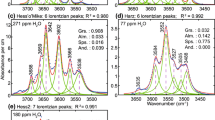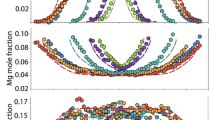Abstract
Garnet is a nominally anhydrous mineral that can incorporate several hundreds of ppm H2O in the form of OH groups, where H+ substitutes for cations in the garnet structure. To understand the effect of such small amounts of H2O on the physical and chemical properties of garnet, it is essential to determine where and how the OH groups are incorporated into the mineral structure. We investigated correlations between major and minor element maps acquired with the electron probe micro-analyser and H2O maps measured with Fourier transform infrared spectroscopy coupled to a focal plane array detector at the microscale to determine possible coupled substitutions. A set of algorithms was developed to match the maps pixel by pixel. They allow the computation of the garnet structural formula taking the H2O content into account and the calculation of correlations between H2O and other elements on the basis of 10,000 s of points. This new approach was applied to two hydrous garnet samples both showing H2O and chemical zoning. The first sample consists of a grossular-rich garnet from a high-pressure metarodingite ranging from 200 to 900 ppm H2O. The second sample contains a Ti-rich andradite garnet ranging from 200 to 8500 ppm H2O. For the grossular-rich garnet, a 1:1 correlation between Ti and H has been observed suggesting that H occurs as tetrahedral (2H)2+ point defect, charge compensated by 2 Ti4+ on the octahedral site. Based on this, a new hydrous garnet endmember with the formula Ca3Ti2H2Si2O12 is proposed. This 2TiVI\(\leftrightarrow\) (2H)IV exchange mechanism is mainly responsible for the high amounts of TiO2 (up to 11 wt%) in the investigated Ti-andradite. The incorporation of (2H)2+ instead of (4H)4+ on the tetrahedral site has important consequences for the normalisation of the garnet and hence on the determination of Fe2+/Fe3+ based on stoichiometry. In the garnet from the metarodingite, a small-scale zoning in H2O contents of less than 100 µm can be resolved, indicating that the Ti–H defect is stable up to eclogite facies conditions and not modified by diffusion even at timescales of millions of years.










Similar content being viewed by others
References
Aines R, Rossman G (1984) The hydrous component in garnets: pyralspites. Am Mineral 69:1116–1126
Amthauer G, Rossman G (1998) The hydrous component in garnets: pyralspites. Am Mineral 83:835–840
Andrut M, Wildner M, Beran A (2002) The crystal chemistry of birefringent natural uvarovites. Part IV. OH defect incorporation mechanisms in non-cubic garnets derived from polarized IR spectroscopy. Eur J Mineral 14:1019–1026
Armbruster T, Birrer J, Libowitzky E, Beran A (1998) Crystal chemistry of Ti–bearing andradites. Eur J Mineral 10:907–921
Arredondo EH, Rossman GR, Lumpkin GR (2001) Hydrogen in spessartine–almandine garnets as a tracer of granitic pegmatite evolution. Am Mineral 86:485–490
Basso R, Cimmino F, Messiga B (1984) Crystal-chemistry of hydrogarnets from 3 different microstructural sites of a basaltic metarodingite from the Voltri-massif (Western Liguria, Italy). Neues Jahrbuch Fur Mineralogie-Abhandlungen 148(3):246–258
Baxter E, Caddick M (2013) Garnet growth as a proxy for progressive subduction zone dehydratation. Geology 41(6):643–646
Berry A, Walker A, Hermann J, O'Neill H, Foran G, Gale J (2007) Titanium substitution mechanisms in forsterite. Chem Geol 242:176–186
Cohen-Addad C, Ducros P, Bertaut EF (1967) Etude de la substitution du groupement SiO4 par (OH)4 dans les composés Al2Ca3(OH)12 et Al2Ca3(SiO4)2.16(OH)3.36 de type grenat. Acta Crystallogr A 23:220–230
Foreman D (1968) Neutron and X-ray diffraction study of Ca3Al2(O4D4)3, a garnetoid. J Chem Phys 48:3037–3041
Geiger CA, Langer K, Bell DR, Rossman GR, Winkler B (1991) The hydroxide component in synthetic pyrope. Am Mineral 76:49–59
Geiger CA, Rossman GR (2018) IR spectroscopy and OH– in silicate garnet: the long quest to document the hydrogarnet substitution. Am Mineral 103:384–393
Handy MR, Schmid SM, Bousquet R, Kissling E, Bernoulli D (2010) Reconciling plate-tectonic reconstructions of Alpine Tethys with the geological-geophysical record of spreading and subduction in the Alps. Earth Sci Rev 102:121–158
Johnson EA (2003) Hydrogen in nominally anhydrous crustal minerals. Dissertation, California Institute of Technology
Jollands M, Kempf E, Hermann J, Müntener O (2019) Coupled inter-site reaction and diffusion: rapid dehydrogenation of silicon vacancies in natural olivine. Geochim Cosmochim Acta 262:220–242
Khomenko VM, Langer K, Beran A, Koch-Müller M, Fehr T (1994) Titanium substitution and OH-bearing defects in hydrothermally grown pyrope crystals. Phys Chem Miner 20:483–488
Kühberger A, Fehr T, Huckenholz HG, Amthauer G (1989) Crystal chemistry of a natural schorlomite and Ti–andradites synthetized at different oxygen fugacities. Phys Chem Miner 16:734–740
Kurka A, Blanchard M, Ingrin J (2005) Kinetics of hydrogen extraction and deuteration in grossular. Mineral Mag 69(3):359–371
Lager GA, Armbruster T, Faber J (1987) Neutron and X-ray diffraction study of hydrogarnet Ca3Al2(O4H4)3. Am Mineral 72:756–765
Lanari P, Vidal O, De Andrade V, Dubacq B, Lewin E, Grosch E, Schwartz S (2014) XMapTools: a MATLAB-based program for electron microprobe X-ray image processing and geothermobarometry. Comput Geosci 62:227–240
Lanari P, Vho, A. Bovay T, Airaghi L, Centrella S (2019) Quantitative compositional mapping of mineral phases by electron probe micro-analyser. In: Ferrero S, Goncalves P, Grosch E (ed) Metamorphic geology: microscale to mountain belts, vol 478. Geological Society of London, Special Publications, London
Lu R, Keppler H (1997) Water solubility in pyrope to 100 kbar. Contrib Mineral Petrol 129:35–42
Maldener J, Hösch A, Langer K, Rauch F (2003) Hydrogen in some natural garnets studied by nuclear reaction analysis and vibrational spectroscopy. Phys Chem Miner 30:337–344
Martin S, Rebay G, Kienast J-R, Mével C (2008) An eclogitised oceanic palaeo-hydrothermal field from the St. Marcel Valley (Italian Western Alps). Ofioliti 33(1):49–63
Müntener O, Hermann J (1994) Titanian andradite in a metapyroxenite layer from the Malenco ultramafics (italy): implications for Ti-mobility and low oxygen fugacity. Contrib Mineral Petrol 116:156–168
O'Haver T (2015) A Pragmatic* Introduction to Signal Processing with applications in scientific measurement; an illustrated essay with free software and spreadsheet templates to download. https://terpconnect.umd.edu/~toh/spectrum/. Accessed 14 July 2018
Reynes J, Jollands MC, Hermann J, Ireland T (2018) Experimental constraints on hydrogen diffusion in garnet. Contrib Mineral Petrol 173(69):68–70
Rossman GR, Aines RD (1991) The hydrous components in garnets: grossular-hydrogrossular. Am Mineral 76:1153–1164
Tartarotti P, Martin S, Monopoli B, Benciolini L, Schiavo A, Campana R, Vigni I (2017) Geology of the Saint-Marcel valley metaophiolites (Northwestern Alps, Italy). J Maps 13(2):707–717
Acknowledgements
We are grateful to G. Bromiley and an anonymous reviewer for their careful reviews, which helped us to improve the presentation of the manuscript, and H. Keppler for editorial handling. This work was financially supported by the Swiss National Science Foundation Grant no. 200021_169062 to J.H. and J.R.
Author information
Authors and Affiliations
Corresponding author
Additional information
Communicated by Hans Keppler.
Publisher's Note
Springer Nature remains neutral with regard to jurisdictional claims in published maps and institutional affiliations.
Electronic supplementary material
Below is the link to the electronic supplementary material.
Supplementary file 2 (AVI 19412 kb)
Rights and permissions
About this article
Cite this article
Reynes, J., Lanari, P. & Hermann, J. A mapping approach for the investigation of Ti–OH relationships in metamorphic garnet. Contrib Mineral Petrol 175, 46 (2020). https://doi.org/10.1007/s00410-020-01681-5
Received:
Accepted:
Published:
DOI: https://doi.org/10.1007/s00410-020-01681-5




